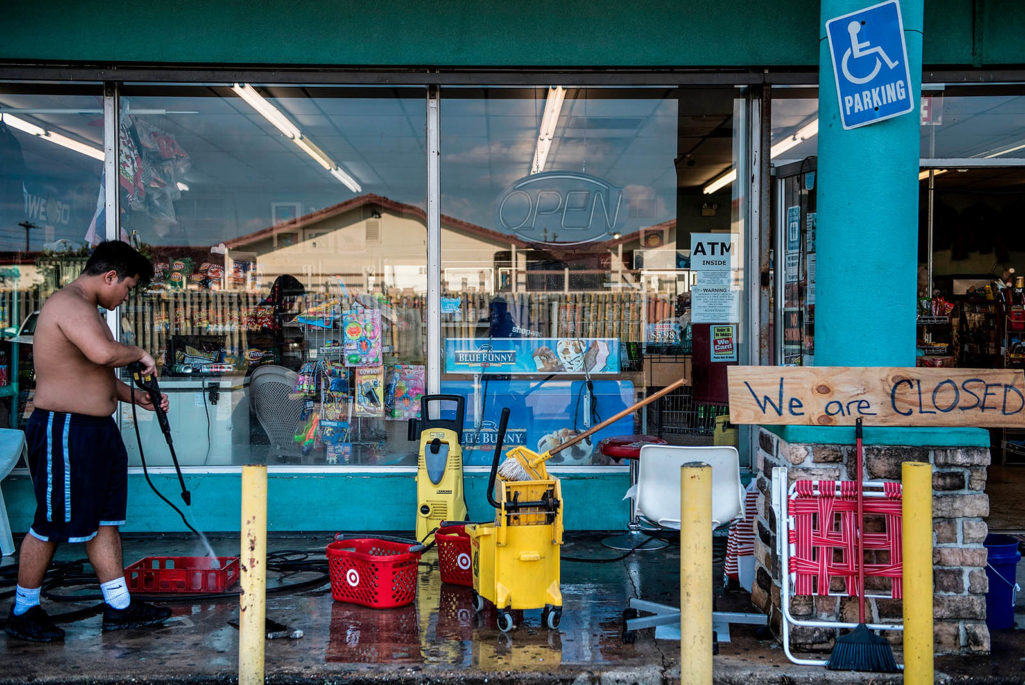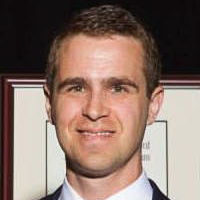Picking up the Pieces: Small and Medium Businesses in the Aftermath of Disaster
An interview with
Jason Nguyen cleans items with a power washer outside a family grocery as residents begin the recovery process from Hurricane Harvey August 31, 2017 in Houston, Texas.
Photo: Brendan Smialowski/AFP/Getty Images
An interview with Ben Collier, Professor of Risk Management, Temple University and Fellow at Wharton Risk Center
Damage estimates from Hurricanes Harvey and Irma are still pouring in and recovery efforts are underway. Historically, small and medium enterprises (SMEs) are particularly hard hit, have less insurance and in the aftermath, face credit restraints when trying to secure the funds to rebuild.
BRINK spoke with Ben Collier, professor of risk management at Temple University and a fellow at the Wharton Risk Center about the effects on SMEs in the aftermath of such disasters, based on his study of those businesses in the aftermath of Superstorm Sandy. Mr. Collier provides insights on why such firms are so dramatically affected and some of the psychology behind why those that pour their life’s savings into a business often fail to insure it fully.
BRINK: What has the history of disasters told us about the impact on small and medium enterprises?
Ben Collier: A consistent theme has been that firms are often unprepared when disaster strikes. Many don’t have disaster plans or insurance in place at that time. Another piece that comes up in the history that we’ve seen commonly is that disasters destroy the property of small and medium enterprises, at least natural disasters do, and those property losses do tend to be big ticket items. These are some of the businesses that lose the most.
More commonly, disasters can create business interruptions due to customer disruption or power outages. Those can be especially challenging. Insuring against those business interruptions is difficult, and often the flood-related interruptions, such as we’ve seen with Hurricane Harvey, and that we saw with Superstorm Sandy, [can] be especially challenging because there are so few [insurance] products that cover those risks.
Some research indicates, too, that SMEs fail at higher rates in the years following disasters due to the challenges of fully recovering. There are some businesses that close their doors when a disaster strikes and never reopen and others that make it a few more years, but they never are fully recovered.
BRINK: How are the effects of a disaster different for SMEs than they are for larger firms?
Mr. Collier: There are a couple different ways I think we could think about this issue, but let me focus on one or two points here. Disasters may be especially challenging for younger firms than for smaller firms.
Entrepreneurs face many risks when they’re starting out. They’re trying to seek out their place in the market. Many can’t operate sustainably before their startup capital runs out. There are a lot of entrepreneurs that may have good ideas, then something gets in the way and they’re not able to make the business viable. New businesses face so many risks that it seems like they may be especially unlikely to worry about rare events, such as hurricanes, because there are so many more probable, likely dangers that will cause them to fail.
As businesses mature the nature of a company’s risk falls. The ones that survive the first years have established themselves in the market by demonstrating their viability. For these firms, disaster risks may become more prominent. You start to worry more about a disaster causing you to fail than the younger firm that’s worried about many different risks that might cause it to fail.
Maybe for these reasons we’ve found that older and larger firms are more likely to buy insurance. So, for example, my colleagues and I studied whether New York area businesses had insurance in place at the time of Superstorm Sandy, and we found that younger firms and smaller firms were especially unlikely to be insured.
Maybe the more fundamental point that you’re asking about is vulnerability, too. Smaller firms tend to be more spatially concentrated. If you think about the local retailer with a single office or a few offices, in Houston, Hurricane Harvey may have affected all of those offices; [at] a bigger firm, not all of their locations would be affected by such an event. The same thing with business lines. Larger firms tend to have a variety of business lines of revenue. We see more specialization with smaller firms.
BRINK: In general, how does thinking about risk impact smaller firms?
Mr. Collier: Thinking about risks can be challenging for all of us. So let me put on the small-firm hat for a minute. Many small business owners went into business because they have some specific type of work that they really like to do and are good at doing. For a lot of these businesses it can be tempting to consider risk management a distraction from that work, from what they got into business to do. If you’re coming at it from that perspective, it would be quite natural for an owner to have this internal narrative that every minute I’m thinking about this [risk management] stuff is a minute that I could be working with my customers.
For a lot of businesses it can be tempting to consider risk management as just a distraction from work.
What we’ve learned from psychology is that we can make very different decisions when we’re going with our gut. When we’re trying to think quickly and intuitively about something we make very different decisions than when we’re planning deliberately for something, especially when it’s a complex topic or it’s [a] really challenging area like risk management.
What we like to see are businesses challenging this natural tendency that’s pushing them to avoid thinking about disasters and instead think about such things more deliberately and plan better.
BRINK: Based on the research that you did in the aftermath of the Superstorm Sandy, for example, how are SMEs likely to respond to Hurricanes Harvey and Irma?
Mr. Collier: What we saw with Sandy was that SMEs frequently weren’t insured. About 30 percent of SMEs that were negatively affected by Sandy had no insurance of any kind. Those numbers were much higher for the young firms. More than 50 percent, close to 60 percent of firms that were five years and younger didn’t have any insurance at all. Even among insured firms, only a portion of their losses were covered.
We found that negatively affected firms were about twice as likely to apply for credit than unaffected firms following Sandy to finance recovery. And these businesses often faced credit constraints. Negatively affected firms were more likely to report that access to financing had decreased and that interest rates had increased or that they were required to use collateral more often than unaffected firms.
This was especially true for younger firms. So we had this picture that the younger firms and smaller firms were least likely to be insured and they’re most likely to face credit constraints after these events. The prognosis is really dire for those firms moving forward.
BRINK: If someone has poured their heart and soul into a business, why then do they fail to insure it against such disasters?
Mr. Collier: This is really a great and tricky question, a challenging question. One reason is the psychology behind it, as we talked about earlier. We are geared to not think about rare events, or want to avoid thinking about them, and just hope for the best. I think that’s part of the challenge. A lot of businesses are credit constrained to begin with. They’re trying to get credit to invest in the business and so there’s this competition between buying insurance and investing more in the business.
One of the potential solutions that we might see related to credit constraints, is that to the extent that lenders or supply chain partners or other firms connected to those small businesses recognize the value of insuring, they may help smaller business overcome those financing constraints. If I’m a lender and I recognize a business really should be insured from certain risks if they’re not right now, maybe I can offer better interest rates or maybe I can help supply some additional credit to make sure they have the right insurance in place.
This interview has been edited and condensed for clarity.




